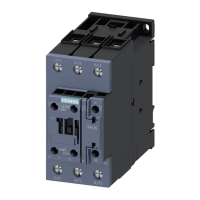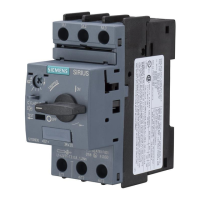Table of contents
SIRIUS Innovations
System Manual, 01/2011, A8E56203870002-03
13
4.10.6 Auxiliary switches, lateral and signaling switches......................................................................457
4.10.7 Auxiliary releases.......................................................................................................................458
4.10.8
Short-circuit protection for auxiliary and control circuits ............................................................458
4.10.9 Conduc
tor cross-sections main circuit .......................................................................................459
4.10.10
Conductor cross-sections auxiliary and control circuits.............................................................460
4.10.11 Short-c
ircuit breaking capacity...................................................................................................462
4.10.11.1
Short-circuit breaking capacity for motor starter protectors..................................................462
4.10.11.2
Short-circuit breaking capacity for motor starter protectors in the IT system .......................464
4.10.11.3
Short-circuit breaking capacity for motor starter protectors with limiter function..................467
4.10.12
Permissible rated data of approved devices for North America (UL/CSA)................................467
4.10.12.1 Approved according to UL
508/CSA C22.2 No. 14 ..............................................................467
4.10.12.2
Approval as "circuit breaker" according to UL 489/CSA C 22.2 No. 5-02 ............................476
4.11 D
imension drawings (dimensions in mm) ..................................................................................478
4.11.1
Dimens
ion drawings for 3RV2 motor starter protectors.............................................................478
4.12 C
ircuit diagrams .........................................................................................................................482
5 SIRIUS 3R
U2/3RB3 overload relays...................................................................................................... 485
5.1
Standards
...................................................................................................................................485
5.1.1
Standards
...................................................................................................................................485
5.2 Produc
t description ....................................................................................................................486
5.2.1
Introduc
tion ................................................................................................................................486
5.2.2 Vers
ions .....................................................................................................................................487
5.2.3 Applic
ations................................................................................................................................488
5.2.4 3RU21 thermal ov
erload relays .................................................................................................490
5.2.5 3RB30/3RB31 s
olid-state overload relays.................................................................................491
5.3 Produc
t combinations ................................................................................................................493
5.4
Func
tions....................................................................................................................................494
5.4.1
Protectio
n against overload, phase failure, and phase asymmetry...........................................494
5.4.1.1 Func
tional principle ....................................................................................................................494
5.4.1.2 Time-delayed overl
oad release..................................................................................................495
5.4.1.3 Tripping c
lasses .........................................................................................................................495
5.4.1.4 Tripping charac
teristics ..............................................................................................................496
5.4.2 Ground-fault protec
tion (3RB31 only) ........................................................................................499
5.4.3 Auxiliary
contacts .......................................................................................................................500
5.4.4 Indic
ation of the operating state.................................................................................................501
5.4.5 Self-monitoring (3RB30/3RB31 only)
.........................................................................................501
5.4.6 Additional functions
....................................................................................................................502
5.5 Configuration
..............................................................................................................................503
5.5.1
Overload rel
ays in motor feeders...............................................................................................503
5.5.1.1 Overload relays in m
otor feeders...............................................................................................503
5.5.1.2 Normal and heavy
-duty starting.................................................................................................504
5.5.1.3 Contac
tor assembly for star-delta (wye-delta) start...................................................................505
5.5.1.4 Operation wit
h frequency converters .........................................................................................505
5.5.2 Short-c
ircuit protection ...............................................................................................................506
5.5.3 Protec
ting explosion-protected motors ......................................................................................506
5.5.4 Applic
ation environment.............................................................................................................506
5.6 Mounting
....................................................................................................................................508
5.6.1 Mounti
ng options........................................................................................................................508
5.6.2 Minimum cl
earances and mounting position..............................................................................508
5.6.3 Mounting/Disassembl
y...............................................................................................................509

